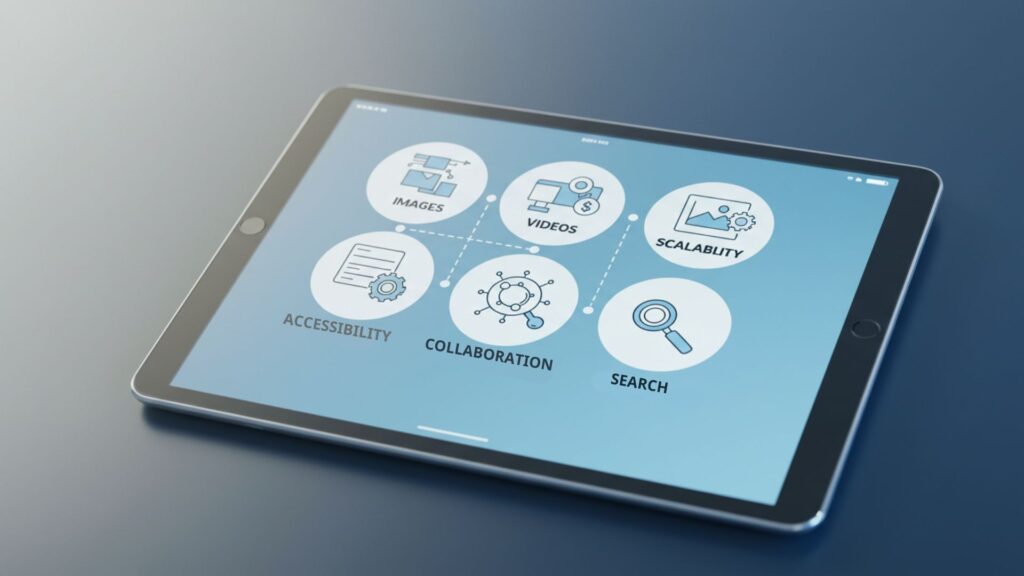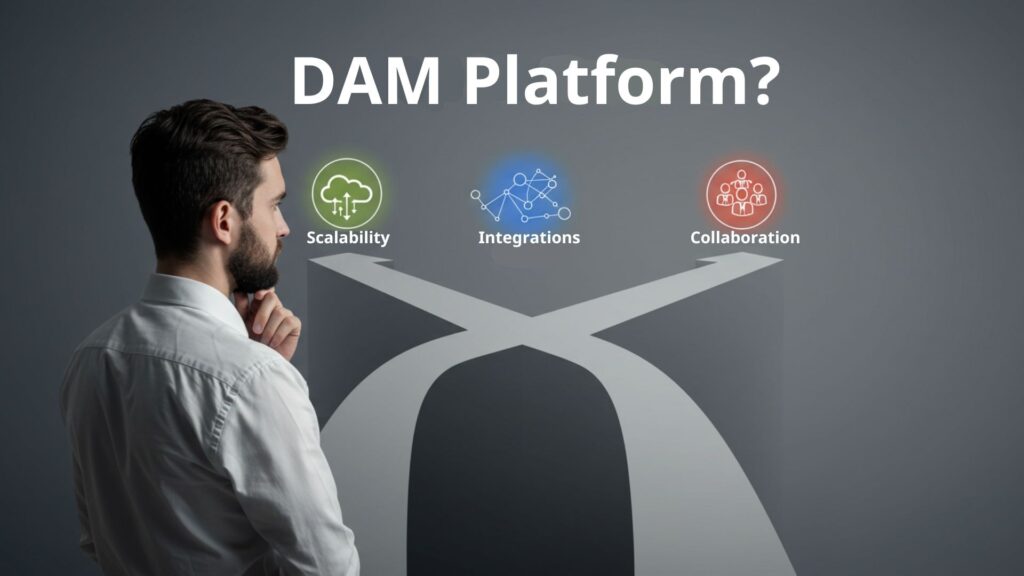Organizations are inundated with an ever-growing volume of digital content. Efficiently managing this vast array of assets has become a critical challenge, leading many to reassess their current systems and processes. As businesses strive to maintain brand consistency, streamline workflows, and enhance collaboration across teams, the question arises: Are existing tools sufficient, or is it time to explore a more robust solution to address evolving DAM needs?
Recent advancements in artificial intelligence (AI) have significantly transformed the realm of digital asset management (DAM). AI-powered features, such as automated tagging and content organization, are revolutionizing how assets are categorized and retrieved, reducing manual effort and increasing accuracy.
According to Forbes, AI’s integration into DAM systems is expected to move more workflow to the background, allowing for more efficient and streamlined operations. It’s time to evaluate whether your organization’s current approach is equipped to leverage these innovations effectively.
What Is Digital Asset Management?
On the surface, DAM technology appears to have some similar content management features, like the ability to store images and videos, as adjacent solutions like Web Content Management (WCM), Cross Channel Campaign Management, and eCommerce platforms.
Digital asset management can indeed work with all these types of solutions, but DAM’s approach to content is different. While other solutions focus on managing content specific to a channel, DAM is optimized to manage omnichannel content creation, management, and sharing. Many DAMs have greatly improved over the years, adding many more robust asset management capabilities.
So, how do you know if your organization can get by with these other solutions or if you have DAM needs now? What is the future of DAM, and will your organizations be impacted?
Five Questions to Determine Your Organization’s DAM Needs
Digital Asset Management has evolved far beyond a simple media library. At its core, a DAM system is purpose-built to organize, store, retrieve, and distribute a wide variety of rich media assets. These include:
- Images and photos
- Video and audio files
- Creative design assets
- Documents and presentations
- Emerging multimedia formats like 3D and interactive content
But with so many content platforms available, how do you know if a dedicated DAM solution is the right fit for your business?

To help clarify your DAM needs, consider the following five strategic questions. Each one is designed to uncover whether your current systems are holding you back and if a DAM can unlock greater efficiency, scalability, and collaboration for your content operations.
Question 1: Is your content siloed in multiple solutions?
While other solutions could manage this content, DAM solutions provide a single repository to access and manage all different types of files.
Instead of having different content versions for your website, email marketing, and PIM, you can now have a single source of truth for all assets in a DAM. You can also use a DAM to build a centralized content library.
By applying metadata and taxonomy, you make assets easier to find, connect related content, and streamline distribution across channels. Enhanced search functionality helps teams quickly locate the most relevant assets, while shared access promotes seamless collaboration across departments, regions, and campaigns.
Question 2: Do you want to do more than park assets?
Many DAMs today go far beyond storing files; they support the full content lifecycle. From ideation and planning to publishing and archiving, modern digital asset management tools are designed to accelerate operations and reduce friction for every team involved in content creation.
One of the key benefits of implementing a DAM system is its support for work-in-progress assets. Creatives can work in their tools of choice while the DAM tracks changes, manages versions, and automates approval workflows.
With AI-powered features like auto-tagging and content recommendations, digital assets become more actionable, closing content gaps and ensuring no valuable asset gets overlooked. This makes it easier for marketing, commerce, and brand teams to scale content efforts across various channels without compromising on quality or consistency.
Question 3: Do you need to support multiple asset types?
Modern DAM systems are built with flexibility in mind. As organizations grow, so do their content needs, and that means managing more than just images.
From high-res video and layered design files to 3D renders and even text-based documents, a robust digital asset management platform supports a wide array of asset formats, ensuring your team can produce and deliver rich experiences across all channels.
With intelligent automation and AI-driven metadata tagging, DAMs help decision-makers understand which assets are most effective—who’s using them, how often, and where. Organizations can build a smarter content strategy, close performance gaps, and deliver more relevant experiences to the right audience at the right time.
When scalability and content intelligence are priorities, supporting multiple asset types is essential.
Question 4: Do you have sophisticated content enrichment needs?
If your organization manages content variations by region, channel, or market, you know how complex enrichment can get. DAM platforms simplify this process through robust features like rights management, dynamic renditions, and AI-powered enrichment tools. These capabilities enable your team to manage localization, brand compliance, and usage permissions from a single source of truth.
When you’re dealing with security concerns, copyright timelines, or on-demand resolution needs, other content tools often fall short. A dedicated DAM provides the structure and automation needed to meet complex enrichment needs, reducing manual work and enhancing governance.

With AI surfacing relevant content and highlighting underutilized digital assets, you can ensure your brand is never held back by outdated systems or hidden content inefficiencies.
Question 5: Are you managing these assets across groups?
The reality for growing organizations is that content is produced and used everywhere from local offices to global headquarters. Your DAM must support collaboration at scale. Enterprise-ready DAM platforms are purpose-built for this. They manage hundreds of thousands of assets across departments, business units, and various channels.
Modern DAM design focuses on cross-functional access, enabling marketers, creatives, sales teams, and partners to find what they need quickly. Advanced security controls ensure only the right people can access sensitive content, while AI recommendations surface relevant assets for each user’s role and region.
When implemented correctly, a DAM becomes the connective tissue of your organization’s content ecosystem, breaking down silos, boosting team efficiency, and turning your library of digital assets into a strategic growth engine.
The Cost of Ignoring DAM Needs
As the volume and complexity of content grows, so does the risk of falling behind without a scalable digital asset management system.
Relying on disconnected tools, local folders, or outdated file-sharing platforms may seem manageable at first, but over time, the hidden costs add up. These include slower campaign execution, inconsistent brand experiences across various channels, and significant time lost searching for or recreating misplaced assets.
Without a centralized DAM system in place, teams often struggle with version control, limited visibility, and siloed workflows, leading to duplicated efforts and reduced marketing agility. As organizations grow, these inefficiencies scale with them, negatively impacting collaboration, campaign performance, and revenue. Ignoring your DAM needs stalls productivity and prevents your brand from delivering cohesive and timely digital experiences.
By proactively investing in the right DAM tools, decision-makers can eliminate bottlenecks, enhance operational efficiency, and set their organization up for long-term content success.
Choosing the Right DAM Design for Your Organization
Selecting the right DAM system depends on your organization’s unique structure, workflows, and goals. A well-designed digital asset management solution should actively support your broader content strategy. This means evaluating core capabilities like scalability, metadata customization, workflow automation, and smart search powered by AI.
Consider how your team collaborates across departments, regions, or brands. Do you need advanced permissions? Do you plan to integrate your DAM with existing tools in your marketing or creative stack?
As organizations grow, the ability to support complex use cases, such as multi-brand architecture, localized content versions, or omnichannel publishing, becomes essential. The right DAM design ensures your system is flexible enough to evolve with your needs, while robust enough to maintain security, compliance, and brand governance from day one.

Ultimately, selecting the right DAM isn’t just about features. Look for a solution that empowers users, adapts to new content formats, and supports continuous innovation through AI and automation. That’s the foundation of a DAM investment that delivers long-term value.
How to Train Teams for Successful DAM Adoption
Implementing a digital asset management system is only the first step. Ensuring your team knows how to use it effectively is what drives real business impact.
Too often, organizations underestimate the importance of structured onboarding and ongoing training, resulting in low adoption rates, poor asset governance, and missed opportunities for collaboration.
A strong rollout strategy should be tailored to each user group. Creatives may need support around uploading and tagging assets with proper metadata, while marketers might focus on campaign planning, asset reuse, and multi-channel distribution.
Role-based access and task-specific workflows are key features that should be reinforced during onboarding. It’s also essential to provide ongoing learning paths, whether through in-app guidance, on-demand resources, or live sessions, so users can continuously build confidence and explore new capabilities.
When teams are empowered and trained to fully leverage the DAM’s tools, the result is smoother operations, stronger brand consistency, faster time-to-market, and better content ROI. A strategic approach to DAM training transforms the system from a storage solution into a collaborative content powerhouse.
Measuring the ROI of Digital Asset Management
For many decision-makers, investing in a digital asset management platform requires clear evidence of long-term value.
Fortunately, today’s DAM solutions offer robust analytics that allow organizations to track usage, performance, and productivity, making ROI measurable and actionable. From improved content reuse to reduced time spent searching for assets, the return on DAM investment often becomes evident within months of implementation.
AI-powered insights can reveal which digital assets are most effective across various channels, identify underutilized content, and highlight opportunities to close content gaps. These data points allow marketing and creative teams to optimize their workflows, reduce redundancy, and make smarter, performance-driven decisions. Additionally, DAM systems help maintain brand consistency, enforce security policies, and ensure compliance.
When implemented with the right features, training, and integration strategy, a DAM system becomes far more than a file repository; it becomes a driver of strategic growth. By aligning your DAM investment with your organization’s broader goals, you’ll unlock the full potential of your brand’s content ecosystem.
The Future of DAM Is Smarter, Faster, and More Strategic
As content demands continue to grow, so does the need for a more intelligent approach to digital asset management. The next generation of DAM is being shaped by automation, AI, and a greater focus on content performance. Features like auto-tagging, speech-to-text transcription, optical character recognition, and predictive analytics are quickly becoming essential. These innovations help teams work faster, improve collaboration, and ensure content is aligned with the needs of both the business and the audience.At Aprimo, we believe DAM should do more than store your assets. It should help you unlock the full potential of your content operations. Our platform is purpose-built for marketing and content-driven organizations, with AI-first features that close content gaps, enhance collaboration, and streamline distribution across various channels. Request a demo and let’s build the future of content together.


